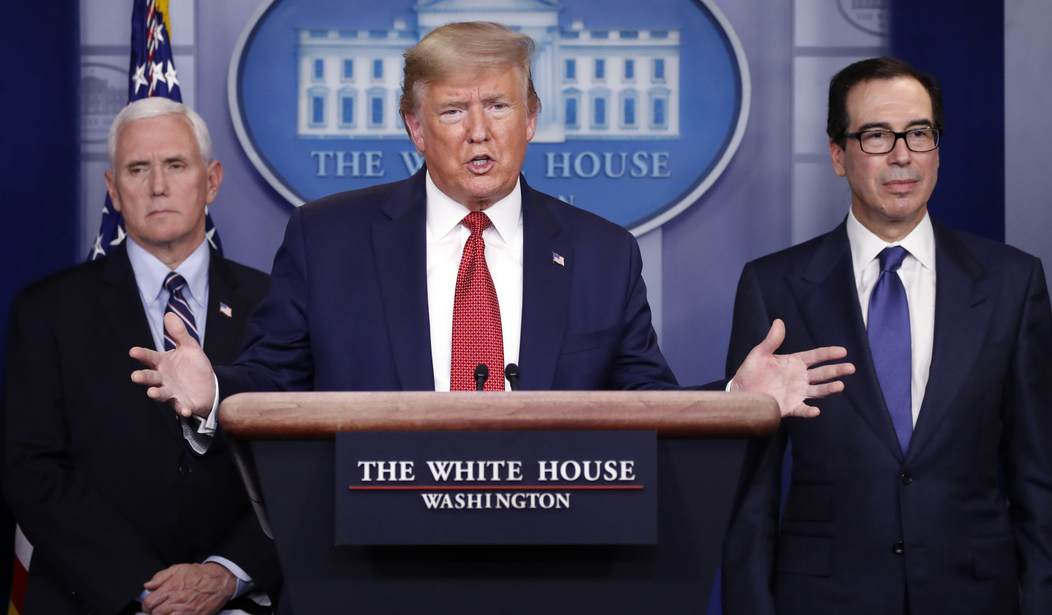President Trump this afternoon signed a $2 trillion spending bill to respond to the health emergency, while the Federal Reserve spent the better part of a trillion dollars this week buying bonds of every description and lending money to foreign central banks. That avoided a financial crisis and stabilized the stock market. When I proposed a massive fiscal stimulus on February 27, I looked like a wild-eyed alarmist, and many readers on this site accused me of playing into a Democratic plot to panic the country and wrong-foot President Trump. Market intervention is like buying a present for the birthday of your spouse; if you’re late, you’ll have to pay a great deal more. A fraction of the $2 trillion tab would have maintained confidence in markets if it had been offered a month ago, but no matter: What had to be done had to be done.
That leaves us with a federal deficit of perhaps $4 trillion — the $1 trillion deficit we ran before the crisis despite full employment, another $1 trillion in lost tax revenues, and $2 trillion in additional spending. That’s nearly a fifth of GDP, unprecedented in peacetime. As I explained earlier this week at the Law and Liberty website, the market for U.S. Treasury securities went into free-fall last week, before the Federal Reserve announced an unlimited budget to buy them. That’s a shot over our bow. We can’t run deficits like this forever. I’m an old supply-sider and during the Reagan years I chanted the mantra, “Deficits don’t matter.” But the federal debt was just 30% of GDP when Reagan took office in 1981, vs. about 110% at the end of this year, not counting perhaps $100 trillion in liabilities of the Social Security and Medicare systems.
We can’t do this forever. Starting with the Clinton Administration, the U.S. has shifted federal spending from investment (roads, bridges, basic R&D, public health, and so forth) into transfer payments. The chart below prepared by the Concord Coalition shows that investment has fallen from 32% of federal spending to just 13% today, while transfer payments have risen from 28% to 70%.
We just found out that this is unsustainable, in case we had any doubts before.
First of all, our public health infrastructure is miserably inadequate. I am writing from New York City, where sick people can’t get tested for coronavirus. There aren’t enough test kits for hospital workers, let alone the public. We simply don’t know what’s going on. Last week, I am reliably informed, Germany tested 750,000 people for coronavirus, and 500,000 the week before. That is, Germany tested 1% of its population in a single week. We’ve tested a cumulative 0.2% to date. It’s early days yet, and we’ll see what the American death toll looks like. Italy, with an awful public health system, already has 138 deaths per 1 million of population vs. 0.3 per million in Japan and 3 per million in Germany. Italy has 2.7 hospital beds per 1,000 people compared to 8 per 1,000 in Germany and 13 per 1,000 in Japan. South Korea, Taiwan, and China have gotten the epidemic under control while we’re still trying to figure out what’s going on.
I’m not blaming President Trump. He inherited this situation and he’s playing the hand he was dealt. When he seemed too complacent about the epidemic–in contrast to canny supporters like Tucker Carlson–I warned that complacency could lose him the election. He isn’t complacent any longer. The fault belongs to Bill Clinton, who frittered away the so-called Cold War peace dividend on federal handouts; to George W. Bush, who got us into endless wars that cost trillions of dollars; and to Barack Obama.
A lot of us thought that the virus would take care of our China problem. If a single English-language media outlet failed to use the phrase “Chernobyl moment” to describe China at the February peak of its Covid-19 epidemic, I haven’t found it. For one brief hopeful moment, the entirety of the Western punditeska was confident that China’s ascendancy had come to a sorry and sudden end. Now that China has reported no new domestic cases for three consecutive days, it appears that Western schadenfreude at China’s misery was a form of denial, the first of the late Elizabeth Kübler-Ross’s five stages of grief.
China combined draconian controls on movement and massive testing with big data analysis of hundreds of millions of smartphone locations, as I reported on March 3.
China has correlated smartphone location with online purchases and social media posts for at least five years and invested massively in public health applications of artificial intelligence. Combining capability with massive amounts of coronavirus test data gave China a decisive advantage in epidemic control. This may be the largest and most sophisticated artificial intelligence experiment ever, and it may well establish China as the world’s dominant AI power. China exploited the crisis to conduct the largest AI exercise in history. To gain access to public spaces in most cities you need to show a “Green Page” on your Wechat app, and to get this, you have to use another Wechat app with attachments to upload your vital signs to the cloud. A government algorithm decides when you can leave isolation, and the government knows where you are at all times (no good borrowing someone else’s phone, because you have to log in with facial or voice recognition). Police patrol the streets with AI-enabled helmets that can determine body temperature at five meters. A smartphone’s location is correlated with updated vital signs and test results.
Whether this really brought the rate of new infections to zero or not is beside the point: China made a gigantic demonstration of its AI capability and–like the other big Asian countries–got the epidemic under control. From a U.S. strategic standpoint that’s the scariest thing about it.
It’s hard to fix your roof when it’s raining, let alone in the middle of a hurricane. When the dust settles and we get back to work, we will have a big decision to make. I’ve argued for years that it would take ten years and $1 trillion in federal support for basic R&D to stay ahead of China. We need another $1 trillion to restore basic infrastructure. We need considerable investment in public health to buttress our system for the next epidemic, whenever it comes. Finding a trillion dollars is a lot harder to do now, when we’re $4 trillion in the hole in the federal deficit, not counting another $1 trillion or so of expansion of the federal balance sheet.
It’s hard to do, but we have to turn this around, or we won’t be a world power for very long. If the world stops financing our deficits, we will have to cut spending suddenly and massively. If you think politics is polarized now, when people are fighting over ideology, wait until they’re fighting over pensions.











Join the conversation as a VIP Member